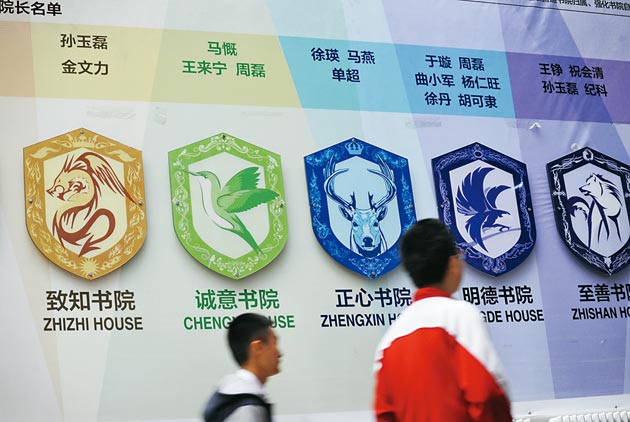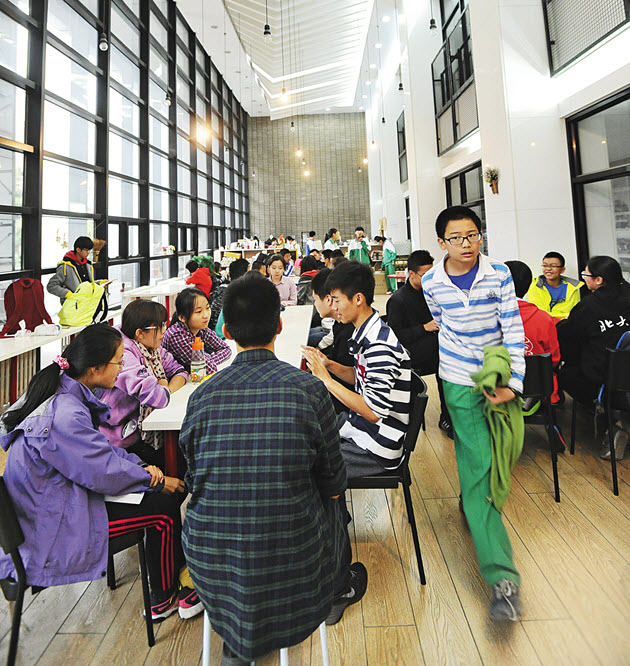Beijing University Affiliated High School
China’s "Hogwarts"

Source:CW
Remember the Hogwarts School featured in the Harry Potter fantasy novel and movie series? Beijing University Affiliated Senior High School is the only high school in China to follow an institute and house structure, giving students full autonomy to arrange their own classes and schedules.
Views
China’s "Hogwarts"
By Jenny ChengFrom CommonWealth Magazine (vol. 586 )
Every morning at seven, the city air thick with smog, loose clusters of two or three Beijing University Affiliated Senior High School (BUAHS) students cross a road not more than 50 meters wide and pass through the school gate. Some arrive on two wheels, dismounting their bicycles with acrobatic skill, then wheeling them along the narrow walkway into the campus.
When the bell rings calling them to class, students dressed in casual clothes, clutching their cell phones and/or tablets, habitually check their class schedules and classroom assignments.
Times for individual teachers’ classes are posted outside each classroom. Placards outside classrooms indicating class years and sections customary in Taiwan are nowhere to be seen. Here, each student’s class schedule is completely different.
Unrestricted Class Selection
Each student can select courses from the school’s four institutes and three activity centers included in the curriculum structure. The institutes include the Learning Action Institute, which consists largely of nationally compulsory courses; the Yuanpei Institute, which stresses in-depth study and interdisciplinary learning; the Boya Institute, which focuses on critical thinking and humanities; and finally the Dalton Institute, which is geared toward preparing applications for overseas studies.
The school’s three centers include the Visual and Performing Arts, Sports and Health Education, and Information and General Technology centers. A broad variety of courses of all descriptions have been developed under the umbrella of the seven institutions.
On this particular day, Liu Shuhong and Li Longyun, both sophomores, have widely divergent class schedules. Liu Shuhong likes science, and has filled his schedule with honors courses on biotechnology, chemistry, and physics. The energetic and outgoing Li Longyun has arranged four basketball classes, and has slipped in another one on singing technique, hitting some high notes during class.
“People say that BUAHS is like a university; I just don’t want it to be like an elementary school,” quips school Principal Wang Zheng, who slams that notion home in every speech. Wang believes that there should be differences in the educational structure at each level. High school is a turning point at which students begin to mature, thus it should not be restricted to bland, repetitive curriculum.
Seven Houses, Student Autonomy
Breaking from conventional set class assignments for freshmen and sophomores, this approach has given rise to a system under which students arrange courses as individuals. This way, each teacher is like a student class director as well as subject instructor. Mixing of class sections and course selection has accordingly become one of BUAHS’ defining characteristics.
Lacking shared experience across class levels, BUAHS is the first in China to adopt a “house” system to help give students a sense of identity and belonging. BUAHS’s houses are autonomous organizations run by students, each with its own cultural continuum. Each of the seven houses has a different culture and characteristics, whether defined by top academic students or athletes. Each house has its own logo and color identification system, lending to the school’s overall diversity and color in their own way.
In addition to house leaders reporting on the financial budget and execution at council meetings, each house must create its own activity room. Each house gets a budget of 20,000 RMB from the school every year for students to conceive, plan, and arrange assorted events and activities.
Like the Hogwarts School in the Harry Potter series, BUAHS even holds its own sort of Quidditch tournament, except that they compete at basketball and dance instead. This brings each house together and fosters house identity.
BUAHS biology teacher Yu Xun says that the house system helps train students’ ability to choose, as well as cultivate social skills and self-organization.
Upon acceptance to the high school, each freshman must give thought to which house they would like to join. And students are accountable for having made that choice.
A Curriculum Market
In practice, getting one’s choice of classes is not as easy as one would think. At university, class choice often comes down to speed, but high school students must be assured of getting into classes they choose.
Consequently, each student at BUAHS gets 100 points, which they can then allot to courses of their choice. Some students even go so far as to place all 100 points toward one particular class to ensure they can take it.
The selection system then weighs selections by points and ranks them, and teachers’ evaluation of students’ reasons for their choices is further given consideration, resulting in the final selection.
“Teachers set up the curriculum and students choose their courses. The relationship between teachers and students is no longer one of dependence, and we have even formed a sort of curriculum market based on supply and demand,” says Wang Zheng, confidently. This way, students can see clearly what they really want, acting with true autonomy.
In order to establish a more comprehensive curriculum order, the school set up a Curriculum Committee in 2014 to conceive the entire curriculum from top to bottom.
 Beijing University Affiliated Senior High School is described as the ‘Hogwarts of China’, and each of the school’s seven houses has its own logo and cultural symbolism.
Beijing University Affiliated Senior High School is described as the ‘Hogwarts of China’, and each of the school’s seven houses has its own logo and cultural symbolism.
Curriculum Committee chairperson, Li Dongmei, has a lot of responsibility on her shoulders. “I go around picking fights with different teachers every day!” the long-haired, affable Li says with a big, loud laugh.
It may seem like “fighting” to her, but Li Dongmei must hold six meetings every week to touch base with teachers from each academic discipline and talk about the core values and lessons each discipline wishes to communicate. They then go on to discuss how to incorporate these ideals and values in the classroom, and how to develop modes of thought to guide students in problem solving.
Li gives the example of information courses, where information awareness is the main value, requiring keen sensitivity toward information and knowing how to use various techniques to resolve problems.
Once the values are understood, whether studying animation or programing, she has each student complete a project with the skills acquired in each class. In these two classes, students consider what sort of problems they can solve with the tools available to them, and think about how to solve them.
Curriculum planning at BUAHS is no longer up to individual teachers, but is predicated on satisfying students’ needs.
“The school gives us the freedom we desire, not unfettered indulgence,” says Xinmin House student Sun Yinan, sporting an outfit of her own design. Sitting in the fine arts classroom, where art works are piled all over a haphazard arrangement of four or five desks, she is fashioning a piece with three-dimensional cells, painstakingly wrapping each cell tightly in an outer kernel by hand.
While they may not wave magic wands like they do at Hogwarts, Beijing University Affiliated Senior High School students are given full rein, tempered with the creative energy to run free even without flying brooms or magic wands.
Translated from the Chinese by David Toman






